26th August, 2025
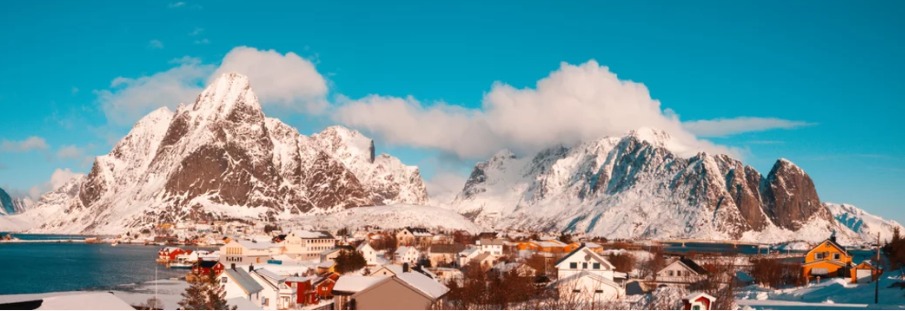
Apr 18, 2024
Island Peak Climbing in December
- Why Island Peak in December
- I Never Climbed a Mountain, Can I Climb Island Peak?
- Packing Lists For Island Peak Climbing
- Training for Island Peak
- Weather, Climate, and Temperature in Island Peak in December
- Solo Climbing to Island Peak
- Is Island Peak Dangerous in December?
- I am a Beginner Climber, Can I Do This Climb?
- How Hard is the Climb of Island Peak?
- Distance of Island Peak
- Conclusion
- Island Peak Climbing Packages
Climbing Island Peak in December offers a unique adventure amidst the tranquil beauty of the Everest region's winter landscape. Standing at 6,189 meters (20,305 feet), Island Peak, or Imja Tse, is a popular trekking peak known for its stunning views and challenging ascent, making it an ideal choice for mountaineers seeking both technical skill and Himalayan scenery.
December marks the onset of winter in Nepal, bringing cooler temperatures and occasional snowfall to the Everest region. While the weather can be more unpredictable compared to the autumn months, climbers in December often benefit from quieter trails and fewer crowds, enhancing the sense of solitude and wilderness during the expedition.

ISLAND PEAK CLIMBING
Sherpa Expedition & Trekking (Est.1977) are pleased to announce FOR ADVENTURERS the most awesome, exhilarating & unforgettable climbing and treks on offer anywhere today!...
The average daytime temperatures range from -5 to 10°C (23 to 50°F) at lower altitudes, gradually decreasing as climbers ascend higher. Nights can be considerably colder, requiring appropriate cold-weather gear to stay comfortable and safe. Despite the colder conditions, the crisp air and clear skies provide breathtaking views of snow-capped peaks like Everest, Lhotse, and Ama Dablam, creating unforgettable moments for climbers.
Precipitation in December can vary, with occasional snow showers adding a layer of challenge and beauty to the trekking route. However, the trails are generally quieter, offering a more serene and intimate experience amidst the pristine winter landscape of the Khumbu Valley.
Climbing Island Peak in December requires careful planning and preparation. Adequate acclimatization is crucial to prevent altitude sickness, with climbers typically following a well-paced itinerary that includes rest days and gradual ascents. Experienced guides play a pivotal role in navigating the terrain, managing risks, and ensuring safety throughout the ascent.
The route to Island Peak includes crossing glaciers, negotiating steep snow and ice slopes, and utilizing basic mountaineering techniques such as using crampons and ice axes. These technical challenges add to the thrill and satisfaction of reaching the summit, where climbers are rewarded with panoramic views that stretch across the vast Himalayan landscape.
Overall, climbing Island Peak in December offers adventurers a chance to experience the quiet beauty and challenges of the Everest region's winter environment. It's a journey that combines physical endurance with awe-inspiring natural beauty, leaving climbers with memories of a lifetime and a profound sense of accomplishment atop one of Nepal's iconic peaks.

ISLAND PEAK SUMMIT RETURN BY HELICOPTER
Many of us only dream of standing on a tall peak looking down on the world. This is a great climb that will satisfy this desire. Island Peak, also referred to as Imja Tse, is a 6187-meter high peak in...
Why Island Peak in December
December presents a unique opportunity to climb Island Peak in Nepal, despite being one of the colder months. The appeal lies in the pristine winter landscapes and fewer crowds compared to peak trekking seasons. The weather is generally stable, with clear skies offering panoramic views of the surrounding Himalayan peaks. However, climbers should be prepared for colder temperatures and potential snowfall at higher altitudes.
For beginners, tackling Island Peak in December requires careful preparation and guidance from experienced mountaineers or guides. While it's feasible for novice climbers with adequate training and support, it's crucial to acclimatize properly and be equipped with the right gear for cold weather conditions.
Overall, December offers a quieter and more serene experience on Island Peak, making it an appealing choice for those looking to avoid the crowds and enjoy the beauty of winter in the Himalayas.
I Never Climbed a Mountain, Can I Climb Island Peak?
Climbing Island Peak, located in the Himalayas of Nepal, is a significant challenge even for seasoned mountaineers. However, it is also considered one of the more accessible peaks for those new to mountaineering at high altitudes. Despite its altitude of 6,189 meters (20,305 feet), Island Peak is often chosen by climbers aiming to transition from trekking to basic mountaineering.
For beginners who haven't climbed mountains before, preparation and guidance are crucial. Prior trekking experience at high altitudes is beneficial to acclimatization. Physical fitness is equally vital; regular cardio, strength training, and endurance exercises prepare the body for the demands of high-altitude climbing.
Moreover, many climbers opt for guided expeditions that provide essential support, equipment, and experienced guides familiar with the route. These guides also offer training on basic mountaineering skills like using crampons, ropes, and ice axes.
While Island Peak is achievable for beginners with proper preparation and guidance, it remains a serious endeavor requiring respect for altitude, weather conditions, and physical challenges. With determination, adequate training, and the right support, even those without prior mountain climbing experience can successfully summit Island Peak, gaining an unforgettable experience in the majestic Himalayas.
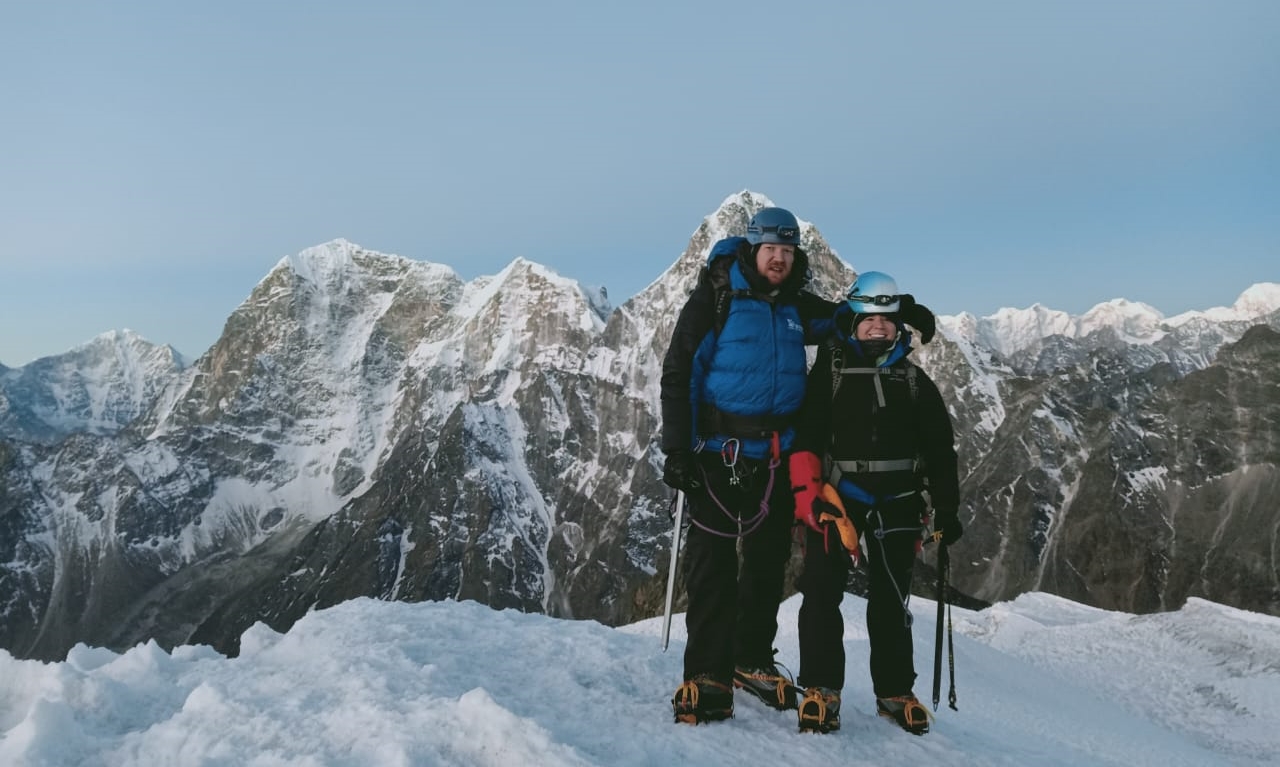
LOBUCHE PEAK CLIMBING
Lobuche East (6,119m/20,075ft), set in Nepal's stunning Khumbu on the Nepalese side of Everest.The best time to go trekking in Nepal is in Autumn (September-November) and in...
Packing Lists For Island Peak Climbing
Packing efficiently and effectively is crucial for a successful climb of Island Peak. Your gear needs to balance weight with functionality, ensuring you have everything necessary while keeping your pack manageable. Here’s a comprehensive packing list:
- Clothing: Base layers, insulated jacket, waterproof jacket and pants, gloves, hat, socks, and sturdy boots.
- Climbing Gear: Helmet, harness, crampons, ice axe, ropes, and carabiners.
- Sleeping Gear: Sleeping bag suitable for sub-zero temperatures and sleeping pad.
- Accessories: Headlamp with extra batteries, sunglasses, sunscreen, lip balm, and a first aid kit.
- Miscellaneous: Trekking poles, water bottles or hydration system, snacks, and toiletries.
- Documents: Passport, permits, insurance details, and emergency contacts.
Prioritize lightweight, moisture-wicking materials that dry quickly and retain warmth even when wet. Layering is key for adapting to changing weather conditions. Pack items in dry bags to protect against moisture. Verify with your tour operator for any specialized gear required.
Efficient packing ensures you're prepared for the challenges ahead while minimizing unnecessary weight, enhancing your comfort and mobility during the climb.
Training for Island Peak
Preparing physically and mentally for an ascent of Island Peak is essential due to its high altitude and challenging terrain. A structured training regimen should focus on improving cardiovascular endurance, strength, and altitude acclimatization.
- Cardiovascular Endurance: Engage in activities like running, cycling, or swimming to enhance your heart and lung capacity. Interval training helps simulate the bursts of effort needed during the climb.
- Strength Training: Build muscle strength, particularly in your legs, core, and upper body. Exercises like squats, lunges, planks, and pull-ups improve stability and endurance, crucial for navigating rocky terrain and using climbing equipment.
- Altitude Acclimatization: Gradually expose yourself to higher altitudes through hikes or treks in mountainous regions. This helps your body adjust to lower oxygen levels and reduces the risk of altitude sickness during the climb.
- Skill Development: Practice basic mountaineering skills such as using crampons, ice axes, and ropes under the guidance of experienced climbers or instructors. Familiarize yourself with safety protocols and emergency procedures.
- Mental Preparation: Develop mental resilience to endure long hours of climbing, adverse weather conditions, and physical discomfort. Visualization techniques and meditation can help manage stress and boost focus.
Consistency in training, adequate rest, and hydration are equally important. Tailor your training plan based on your current fitness level and gradually increase intensity and duration as your climb approaches. A well-rounded training regimen ensures you're physically and mentally prepared to tackle the challenges of Island Peak successfully.
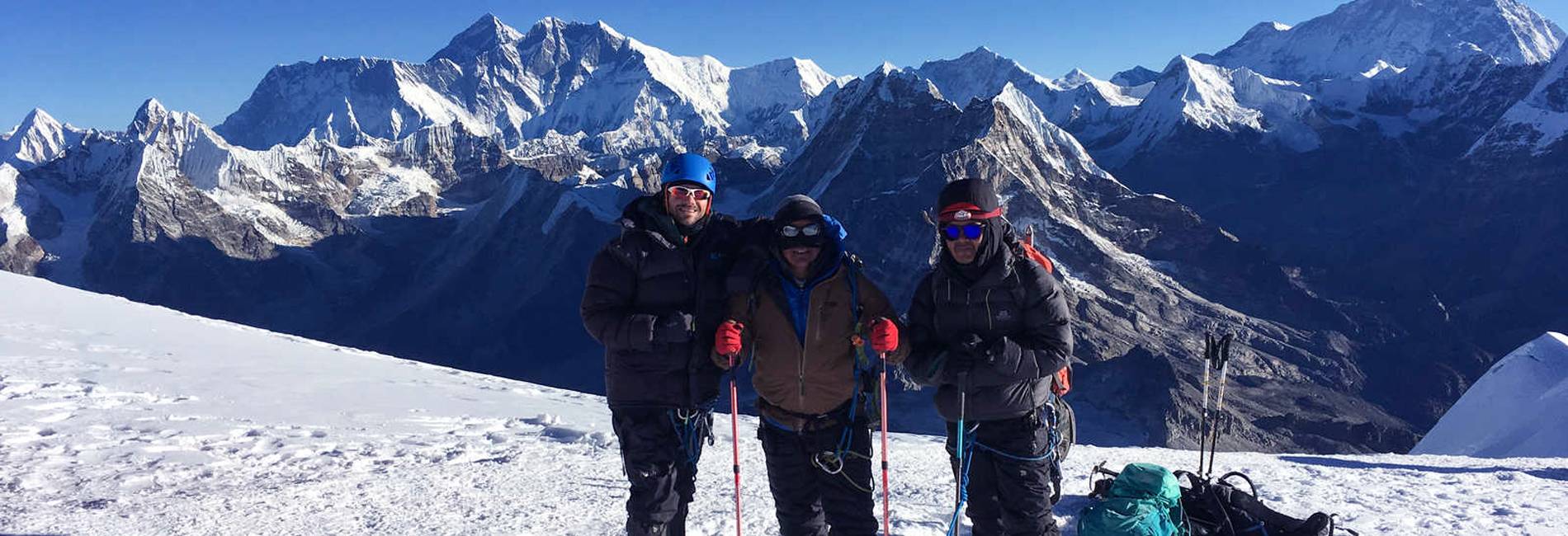
MERA PEAK CLIMBING
Mera Peak Climbing is an exhilarating adventure in Nepal that gives you an opportunity to reach the summit of Mera Peak at more than 6400m above sea level. Actually, it is the highest climbing (w...
Weather, Climate, and Temperature in Island Peak in December
December marks the onset of winter in the Himalayas, including Island Peak. The weather during this month is characterized by cold temperatures and variable conditions. At the base camp and higher elevations, temperatures can drop significantly, often reaching below freezing at night and during early morning hours. Daytime temperatures might range from around -10°C to 5°C (14°F to 41°F), depending on weather patterns.
Snowfall is common in December, which adds to the challenge of climbing Island Peak. The mountain and its surroundings are typically covered in snow, creating picturesque but potentially hazardous conditions. Visibility can vary, and climbers must be prepared for sudden changes in weather, including storms and strong winds.
Proper gear and clothing are crucial to staying warm and dry. Layered clothing, insulated jackets, waterproof outerwear, and sturdy boots with crampons are essential. Climbers should also carry adequate supplies of food, water, and emergency equipment.
December offers stunning views of snow-covered peaks and a quieter climbing season compared to peak months. However, climbers must be vigilant and prepared for the harsh winter conditions that characterize this time of year in the Himalayas.
Solo Climbing to Island Peak
Solo climbing Island Peak is a decision that requires careful consideration and preparation. While technically feasible, solo climbing increases the inherent risks associated with high-altitude mountaineering. Factors to consider include:
- Experience: Solo climbers should have significant experience in mountaineering, preferably including high-altitude climbs and proficiency in using technical equipment like ropes and ice axes.
- Fitness and Acclimatization: Excellent physical fitness and proper acclimatization are crucial for solo climbers. The ability to recognize symptoms of altitude sickness and make sound judgments is essential.
- Equipment and Supplies: Solo climbers must carry all necessary equipment, including safety gear, navigation tools, and emergency supplies. This includes a reliable communication device for emergencies.
- Weather and Conditions: Solo climbers should closely monitor weather forecasts and be prepared to adjust plans accordingly. Weather conditions in the Himalayas can change rapidly and drastically affect climbing conditions.
- Permits and Regulations: Ensure all permits and necessary paperwork are obtained beforehand, as regulations for solo climbing may vary.
While solo climbing offers autonomy and solitude, it amplifies the risks of an already challenging endeavor. Many climbers opt for guided expeditions or climbing with a partner to mitigate risks and enhance safety.

MERA PEAK CLIMBING 17 DAYS
This is an excellent opportunity to climb Nepal’s highest peak without having to obtain a permit (6,476m/21,190ft). From the summit, you will have stunning views of several 8000m plus peaks, such as E...
Is Island Peak Dangerous in December?
Climbing Island Peak in December presents unique challenges primarily due to the winter conditions prevalent in the Himalayas during this month. The dangers associated with December climbing include:
- Cold Temperatures: Sub-zero temperatures can lead to frostbite and hypothermia if climbers are not adequately prepared with appropriate clothing and gear.
- Snow and Ice: Increased snowfall covers the mountain, making routes more technical and hazardous. Avalanches and snowstorms are potential risks.
- Altitude: Island Peak's altitude (6,189 meters or 20,305 feet) poses risks of altitude sickness, including symptoms like headache, nausea, and dizziness. Proper acclimatization is crucial.
- Weather Variability: Weather conditions in December can be unpredictable, with sudden changes in visibility, strong winds, and storms posing significant challenges to climbers.
- Solo Climbing: Solo climbing in December increases risks due to decreased visibility, potential isolation in case of emergencies, and the need for self-reliance.
Despite these risks, many climbers successfully summit Island Peak in December with proper preparation, experience, and adherence to safety protocols. Choosing reputable guides or climbing with experienced partners can mitigate risks and enhance the overall safety of the expedition.
I am a Beginner Climber, Can I Do This Climb?
As a beginner climber, tackling Island Peak presents a significant challenge but is achievable with adequate preparation and guidance. While it's essential to have prior trekking experience at high altitudes, many beginners successfully summit Island Peak each year. Opting for guided expeditions provides crucial support, including equipment, experienced guides, and training in basic mountaineering skills. With commitment to physical training, altitude acclimatization, and mental preparedness, beginners can overcome the challenges of Island Peak, gaining invaluable experience in the process.
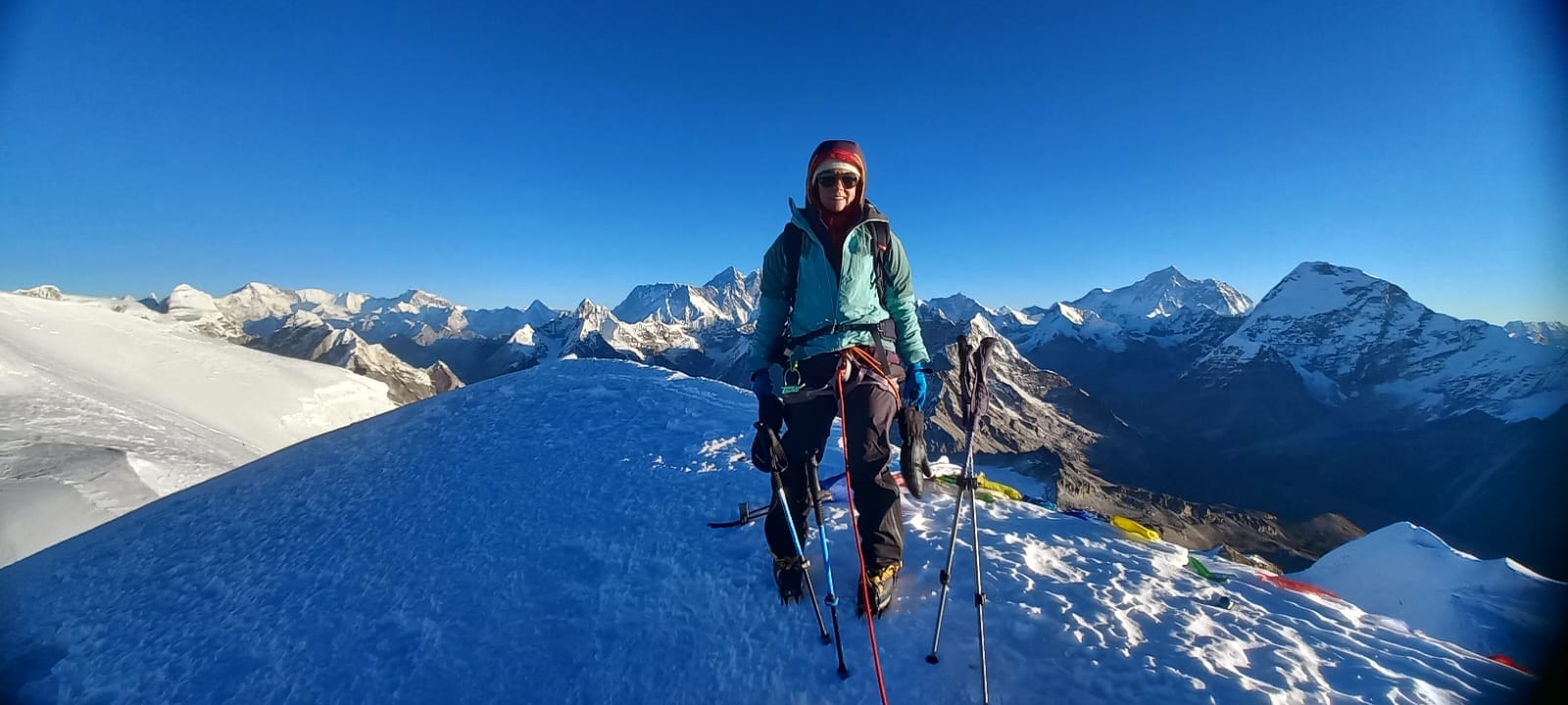
Three Peak Expedition
Embark on an unforgettable journey to the heart of the Himalayas as you conquer three majestic peaks: Mera Peak, Island Peak, and Lobuche Peak. This ultimate adventure combines technical climbing, bre...
How Hard is the Climb of Island Peak?
Island Peak is considered a moderately difficult climb in mountaineering terms. While not as technically demanding as some of the higher peaks in the Himalayas, it requires basic mountaineering skills such as using crampons, ropes, and ice axes. The final ascent involves steep sections and a glacier crossing, which can be challenging depending on weather conditions and route conditions. The altitude (6,189 meters or 20,305 feet) adds to the difficulty, necessitating careful acclimatization and stamina. Overall, Island Peak demands physical fitness, mental resilience, and adherence to safety protocols for a successful ascent.
Distance of Island Peak
Island Peak is situated in the Khumbu region of Nepal, near the famous Everest Base Camp. The distance to Island Peak varies depending on the trekking route chosen, typically starting from Lukla after a short flight from Kathmandu. From Lukla, trekkers typically follow the Everest Base Camp trekking route to reach Island Peak Base Camp. The direct distance from Lukla to Island Peak Base Camp is approximately 50 kilometers (31 miles), but the trekking distance is longer due to the terrain and altitude gain. It usually takes around 10 to 12 days to reach Island Peak Base Camp from Lukla, allowing for proper acclimatization and gradual ascent.
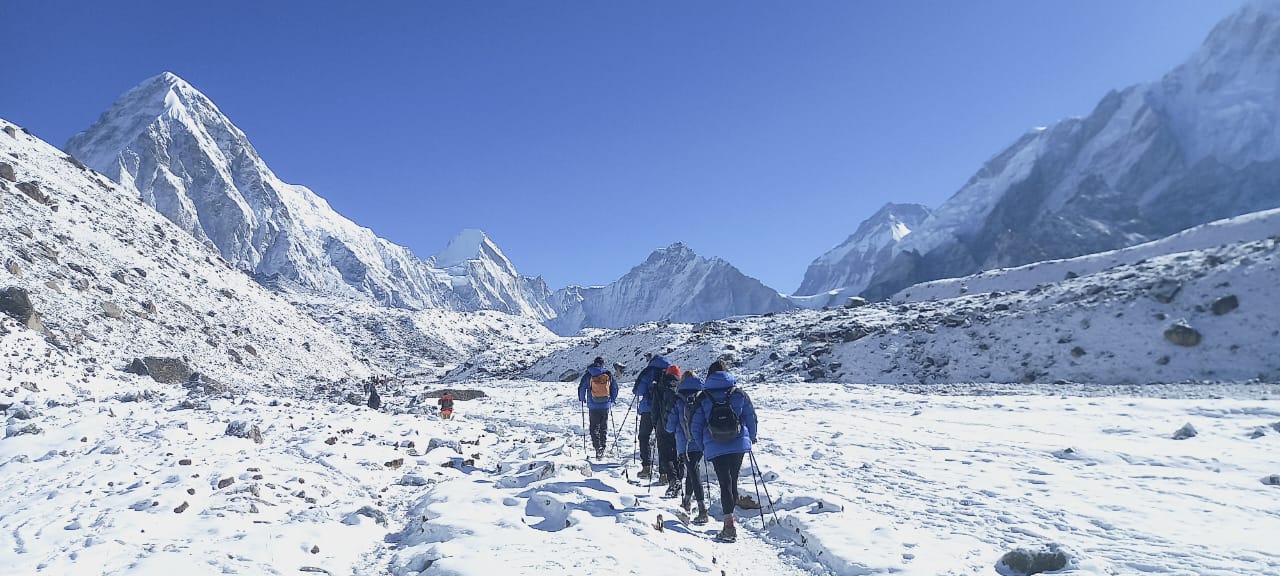
MERA AND ISLAND PEAK CLIMBING
Embark on a thrilling mountaineering adventure like no other with the Mera and Island Peak Climbing expedition crafted by We Sherpa Expedition and Trekking. This exclusive package is designed for adve...
Conclusion
Island Peak, while challenging, is within reach for determined climbers willing to prepare adequately. Whether you're a beginner or seasoned climber, success hinges on physical conditioning, altitude acclimatization, and preparation with experienced guides. The climb offers breathtaking views of the Himalayas and a chance to experience high-altitude mountaineering in a relatively accessible manner. With proper training, gear, and respect for the mountain environment, Island Peak promises an unforgettable adventure and achievement for those willing to take on the challenge.
Island Peak Climbing Packages
Island Peak Summit Return By Helicopter
Island Peak Expedition 14 Days
Island Peak Expedition 15 Days
Everest Three Pass with Island Peak Climbing
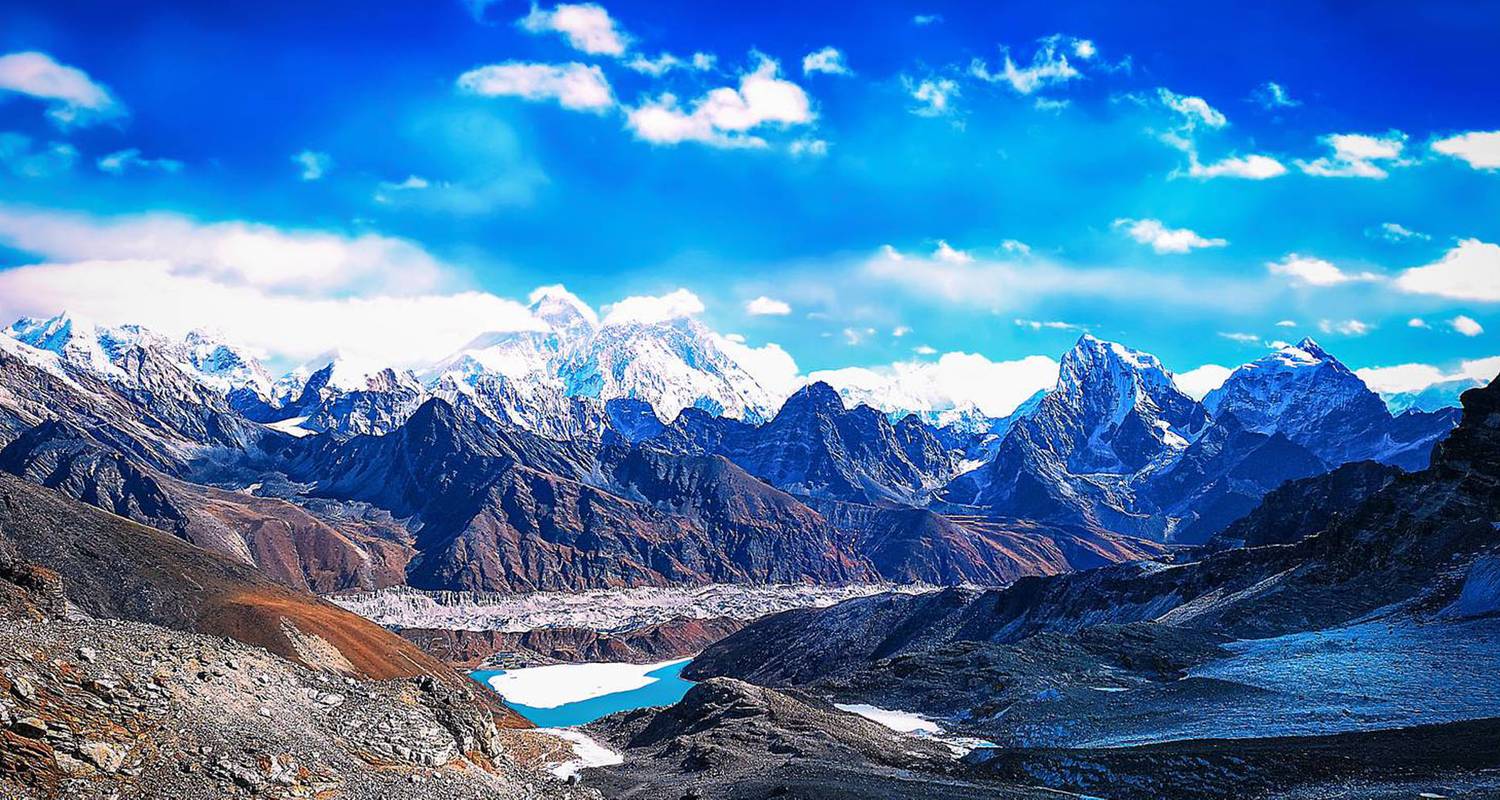
Everest Three High Pass Trek with Island Peak Climbing
The Everest Three High Pass Trek with Island Peak Climbing is an exhilarating and challenging adventure that takes you through the stunning landscapes of the Everest region in Nepal. This 23-25...
Any Questions? Let Us Know.
Recent Posts
17th June, 2025


















